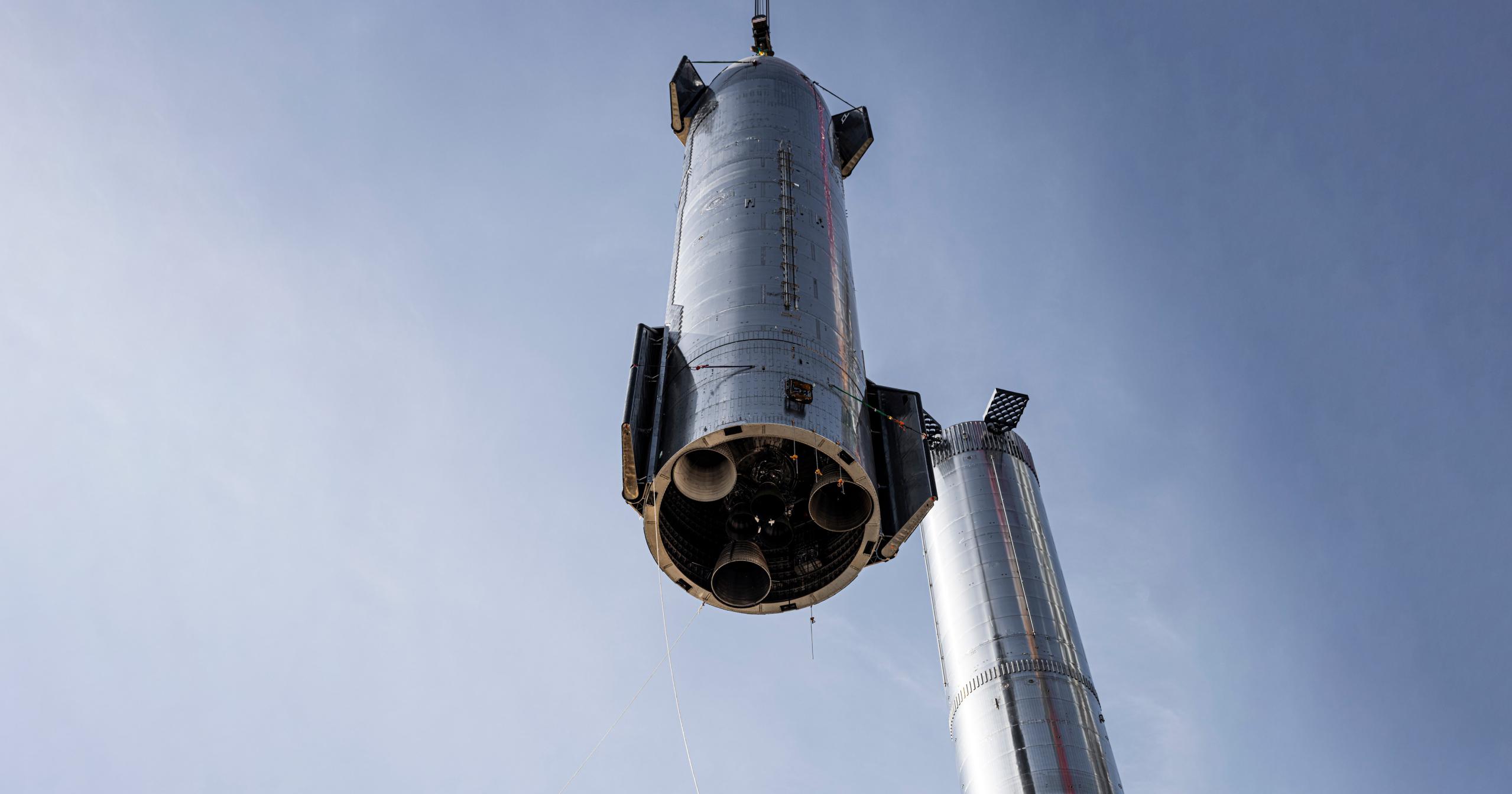

News
SpaceX to upgrade Starship with 50% more Raptor engines
SpaceX CEO Elon Musk says that future Starships – or at least certain Starship variants – are being upgraded with 50% more Raptor engines and stretched propellant tanks.
On December 17th, the CEO revealed the plans, confirming a tweet published three months prior stating that Starship was “begging for an extra 3 engines.” Musk was likely referring to the fact that a 9-engine Starship – combined with upcoming 33-engine Super Heavy boosters – would create a rocket with 42 engines, a number made famous as “the answer to the ultimate question of life [and everything]” in Hitchhiker’s Guide to the Galaxy – both of which the CEO vocally enjoys. As ever, it’s thus almost impossible to tell jokes from serious, consequential plans – as is the case with Starship.
Nonetheless, origination aside, adding another three Raptor engines to Starship – boosting the count from six to nine – and stretching its tanks could be a substantial upgrade.
According to amateur modelers, who are generally able to estimate rocket performance with enough information about its structures, shape, and engines; an optimal nine-engine Starship’s tanks would be stretched about 25% to store an additional 300 tons (650,000 lb) of cryogenic liquid oxygen and methane (LOx/LCH4). That upgraded Starship would have a liftoff mass close to 1600 tons (3.5M lb) and stand about 55 meters (~180 ft) tall – 10% taller than current ships.
At stage separation, close to vacuum, a stretched Starship with three sea-level-optimized Raptors (RCs) and six vacuum-optimized Raptors (RVacs) should produce at least 2000 tons (4.4M lbf) of thrust – and possibly more than 2250 tons (~5M lbf) depending on engine performance. At that upper level of thrust, Starship – an upper stage – would be just 10% less powerful than the first stage of Falcon Heavy, the most powerful operational rocket in the world.
Regardless of its thrust, dimensions, or weight, what matters most is how a stretched, nine-engine Starship would impact that overall rocket’s launch performance. If unofficial modelers are to be believed, the results are significant: compared to a ‘normal’ Starship with a six-engine upper stage and 33-engine booster, the stretched ship could theoretically boost the amount of payload the rocket can launch to low Earth orbit (LEO) from about 150 tons to 220 tons or more (330,000 to 485,000+ lb) – an almost 50% improvement. In fact, per another recent comment from Musk indicating that Starship – unlike almost all other rockets – won’t temporarily throttle down on ascent, the total payload performance could be a bit less than 230 tons (~500,000 lb) – more than 50% greater than a shorter six-engine Starship.
If those estimates are accurate, upgrading Starship with nine Raptors and stretching its tanks is a no-brainer. It might slow development and make all nine-engine ships cost a substantial fraction more but a 50% improvement in payload performance would significantly improve the efficiency of Starship’s more ambitious Moon and Mars launch profiles, which require numerous orbital refuelings.
In effect, a 50% payload increase would allow SpaceX to complete most refueling tasks more efficiently, quickly, and cheaply. Even if the upgrade plans mean that all Starships will be stretched and carry nine Raptors, fully refueling the new Starship variant in LEO could require 7 tanker launches instead of 8-10. If SpaceX doesn’t mind maintaining multiple distinct Starship variants, which appears to be the case, then ships that are exclusively dependent on refueling (Moon and Mars landers in particular) could stay at their current size, with ~1200 tons (~2.6M lb) of propellant storage and six Raptors. A fleet of upgraded Starships could thus refuel their smaller siblings with just 5-6 tanker launches.
However, there’s a good chance that the extra mass required to stretch Starship ~5.5m (~4 tons or ~9000 lb) is minor enough that SpaceX will instead stretch all Starship variants. In fact, for variants like NASA’s HLS Moon lander and future Marsbound Starships, which depend entirely on refueling to reach their destinations, stretched tanks and more propellant storage could increase the amount of payload they could send to the Moon, Mars, and other high-energy destinations by quite a bit. Ultimately, it will be fascinating to hear more details from SpaceX and Musk on how exactly the upgraded Starship design might benefit those operations in the coming weeks and months.
News
Tesla begins Robotaxi certification push in Arizona: report
Tesla seems serious about expanding its Robotaxi service to several states in the coming months.

Tesla has initiated discussions with Arizona transportation regulators to certify its driverless Robotaxi service in the state, as per a recent report from Bloomberg News. The move follows Tesla’s launch of its Robotaxi pilot program in Austin, Texas, as well as CEO Elon Musk’s recent comments about the service’s expansion in the Bay Area.
The Arizona Department of Transportation confirmed to Bloomberg that Tesla has reached out to begin the certification process for autonomous ride-sharing operations in the state. While details remain limited, the outreach suggests that Tesla is serious about expanding its driverless Robotaxi service to several territories in the coming months.
The Arizona development comes as Tesla prepares to expand its service area in Austin this weekend, as per CEO Elon Musk in a post on X. Musk also stated that Tesla is targeting the San Francisco Bay Area as its next major market, with a potential launch “in a month or two,” pending regulatory approvals.
Tesla first launched its autonomous ride-hailing program on June 22 in Austin with a small fleet of Model Y vehicles, accompanied by a Tesla employee in the passenger seat to monitor safety. While still classified as a test, Musk has said the program will expand to about 1,000 vehicles in the coming months. Tesla will later upgrade its Robotaxi fleet with the Cyercab, a two-seater that is designed without a steering wheel.
Sightings of Cybercab castings around the Giga Texas complex suggests that Tesla may be ramping the initial trial production of the self-driving two-seater. Tesla, for its part, has noted in the past that volume production of the Cybercab is expected to start sometime next year.
In California, Tesla has already applied for a transportation charter-party carrier permit from the state’s Public Utilities Commission. The company is reportedly taking a phased approach to operating in California, with the Robotaxi service starting with pre-arranged rides for employees in vehicles with safety drivers.
News
Tesla sets November 6 date for 2025 Annual Shareholder Meeting
The automaker announced the date on Thursday in a Form 8-K.

Tesla has scheduled its 2025 annual shareholder meeting for November 6, addressing investor concerns that the company was nearing a legal deadline to hold the event.
The automaker announced the date on Thursday in a Form 8-K submitted to the United States Securities and Exchange Commission (SEC). The company also listed a new proposal submission deadline of July 31 for items to be included in the proxy statement.
Tesla’s announcement followed calls from a group of 27 shareholders, including the leaders of large public pension funds, which urged Tesla’s board to formally set the meeting date, as noted in a report from The Wall Street Journal.
The group noted that under Texas law, where Tesla is now incorporated, companies must hold annual meetings within 13 months of the last one if requested by shareholders. Tesla’s previous annual shareholder meeting was held on June 13, 2024, which placed the July 13 deadline in focus.
Tesla originally stated in its 2024 annual report that it would file its proxy statement by the end of April. However, an amended filing on April 30 indicated that the Board of Directors had not yet finalized a meeting date, at least at the time.
The April filing also confirmed that Tesla’s board had formed a special committee to evaluate certain matters related to CEO Elon Musk’s compensation plan. Musk’s CEO performance award remains at the center of a lengthy legal dispute in Delaware, Tesla’s former state of incorporation.
Due to the aftermath of Musk’s legal dispute about his compensation plan in Delaware, he has not been paid for his work at Tesla for several years. Musk, for his part, has noted that he is more concerned about his voting stake in Tesla than his actual salary.
At last year’s annual meeting, TSLA shareholders voted to reapprove Elon Musk’s compensation plan and ratified Tesla’s decision to relocate its legal domicile from Delaware to Texas.
Elon Musk
Grok coming to Tesla vehicles next week “at the latest:” Elon Musk
Grok’s rollout to Tesla vehicles is expected to begin next week at the latest.

Elon Musk announced on Thursday that Grok, the large language model developed by his startup xAI, will soon be available in Tesla vehicles. Grok’s rollout to Tesla vehicles is expected to begin next week at the latest, further deepening the ties between the two Elon Musk-led companies.
Tesla–xAI synergy
Musk confirmed the news on X shortly after livestreaming the release of Grok 4, xAI’s latest large language model. “Grok is coming to Tesla vehicles very soon. Next week at the latest,” Musk wrote in a post on social media platform X.
During the livestream, Musk and several members of the xAI team highlighted several upgrades to Grok 4’s voice capabilities and performance metrics, positioning the LLM as competitive with top-tier models from OpenAI and Google.
The in-vehicle integration of Grok marks a new chapter in Tesla’s AI development. While Tesla has long relied on in-house systems for autonomous driving and energy optimization, Grok’s integration would introduce conversational AI directly into its vehicles’ user experience. This integration could potentially improve customer interaction inside Tesla vehicles.
xAI and Tesla’s collaborative footprint
Grok’s upcoming rollout to Tesla vehicles adds to a growing business relationship between Tesla and xAI. Earlier this year, Tesla disclosed that it generated $198.3 million in revenue from commercial, consulting, and support agreements with xAI, as noted in a report from Bloomberg News. A large portion of that amount, however, came from the sale of Megapack energy storage systems to the artificial intelligence startup.
In July 2023, Musk polled X users about whether Tesla should invest $5 billion in xAI. While no formal investment has been made so far, 68% of poll participants voted yes, and Musk has since stated that the idea would be discussed with Tesla’s board.
-

 Elon Musk1 week ago
Elon Musk1 week agoTesla investors will be shocked by Jim Cramer’s latest assessment
-

 Elon Musk3 days ago
Elon Musk3 days agoElon Musk confirms Grok 4 launch on July 9 with livestream event
-

 Elon Musk14 hours ago
Elon Musk14 hours agoxAI launches Grok 4 with new $300/month SuperGrok Heavy subscription
-

 News7 days ago
News7 days agoTesla Model 3 ranks as the safest new car in Europe for 2025, per Euro NCAP tests
-

 Elon Musk2 weeks ago
Elon Musk2 weeks agoA Tesla just delivered itself to a customer autonomously, Elon Musk confirms
-

 Elon Musk1 week ago
Elon Musk1 week agoxAI’s Memphis data center receives air permit despite community criticism
-

 Elon Musk2 weeks ago
Elon Musk2 weeks agoTesla’s Omead Afshar, known as Elon Musk’s right-hand man, leaves company: reports
-

 News2 weeks ago
News2 weeks agoXiaomi CEO congratulates Tesla on first FSD delivery: “We have to continue learning!”













